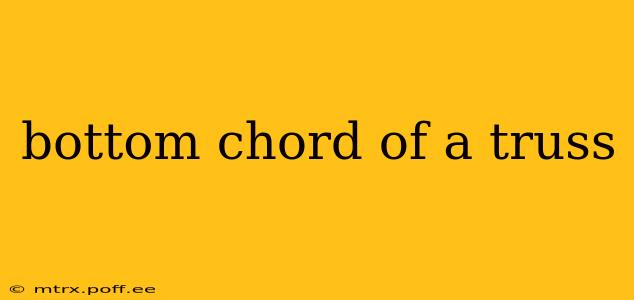Trusses are essential structural elements found in bridges, roofs, and many other structures. Understanding their components is crucial for engineers, architects, and anyone interested in structural design. This guide focuses on the bottom chord of a truss, explaining its function, design considerations, and common FAQs.
What is the Bottom Chord of a Truss?
The bottom chord is the lowermost horizontal member of a truss structure. It works in conjunction with the top chord (the uppermost horizontal member) and the web members (the diagonal and vertical members) to distribute loads efficiently. Think of it as the foundation of the truss, supporting the entire structure's weight and transferring it to the supports. The bottom chord is typically under compression in some sections and tension in others, depending on the loading conditions and truss design.
What is the function of the bottom chord?
The primary function of the bottom chord is to resist tensile forces. When a load is applied to the truss, the bottom chord is subjected to stretching forces. These forces are transferred from the web members, which themselves transmit loads from the top chord. The bottom chord essentially acts as a strong, continuous member that carries these tensile forces to the supports. The efficient transfer of these forces is essential to maintaining the structural integrity of the entire truss.
How does the bottom chord differ from the top chord?
While both chords are crucial, they experience different types of stresses:
- Bottom Chord: Primarily resists tensile forces (pulling forces).
- Top Chord: Primarily resists compressive forces (pushing forces).
This difference in stress dictates the material selection and design considerations for each chord. For instance, a bottom chord might need to be designed with a higher tensile strength than the top chord, depending on the specific loading conditions.
What materials are typically used for bottom chords?
The material chosen for the bottom chord depends on factors like the overall design of the truss, the magnitude of the expected loads, and budgetary considerations. Common materials include:
- Steel: A popular choice due to its high tensile strength and relatively low cost. Steel bottom chords are frequently used in larger structures.
- Wood: Used in smaller-scale trusses, particularly in residential construction. The selection of wood species is important, ensuring it meets the required strength and durability standards.
- Aluminum: Lighter than steel, aluminum is sometimes preferred where weight is a critical concern. However, it may not be as strong as steel.
- Composite materials: These materials, often combining different materials like fiber-reinforced polymers with other materials, are increasingly used in truss construction to achieve specific strength-to-weight ratios.
How is the bottom chord designed?
The design of the bottom chord involves several crucial considerations:
- Load calculations: Accurate load analysis is essential to determine the forces acting on the bottom chord and ensure it can withstand these forces.
- Material selection: As mentioned earlier, selecting the right material is key to achieving adequate strength and durability.
- Cross-sectional area: The cross-sectional area of the bottom chord influences its ability to resist tensile forces. A larger cross-sectional area provides greater tensile strength.
- Connections: The connections between the bottom chord and the web members are crucial for the transfer of forces. These connections need to be robust and reliable.
What are common failures in bottom chords?
Failures in bottom chords are rare but can occur due to:
- Overloading: Exceeding the designed load capacity of the truss can lead to failure in the bottom chord or other components.
- Corrosion: In steel bottom chords, corrosion can weaken the material, reducing its tensile strength.
- Fatigue: Repeated cyclic loading can lead to fatigue failure, especially in areas of high stress concentration.
- Poor design or construction: Inadequate design calculations, incorrect material selection, or poor workmanship can significantly compromise the strength of the bottom chord.
This comprehensive guide provides a solid foundation for understanding the bottom chord of a truss. Remember, proper design and construction are paramount to ensuring the safety and stability of any structure utilizing this vital element. Always consult with qualified structural engineers for any design or construction projects involving trusses.
